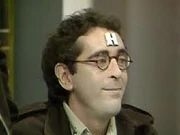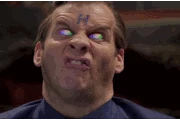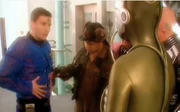Holograms are a major plot theme in the Red Dwarf franchise. One of the central characters, Arnold Rimmer, has been dead for three million years, but remains about the mothership as a holographic resurrection of his former self.
Definition
- Hologram
- (noun) a special type of picture in which the objects seem to be three-dimensional
Oxford English dictionary
- Hologram
- (noun) a special type of photograph or image made with a laser in which the objects shown look solid, as if they are real, rather than flat
Cambridge English dictionary
Soft-light holograms

Red Dwarf Series 1-8 Boxset special features; the hologram Arnold Rimmer, grey-scale as originally intended. The grey-scale effect would be ditched for budgetary reasons and replaced by "Captain Emerald" uniforms. The grey-scale effect was continued in the Red Dwarf Smegazine

How the grey-scale was originally intended. From the Twitter feed of Doug Naylor.
Holograms as used on Red Dwarf are computer simulations of humans, typically deceased. Their memories, personality, knowledge, and skills are copied from their organic brains and are stored on disk. From this, a computer simulated hologram is created of them, composed entirely of light. A hologram has the same drives, emotions and thoughts as a regular human, only cannot touch or interact with the physical world (though they can interact with holographic objects and fellow holograms).
Most holograms are resurrected forms of the mega-rich (see Infinity Welcomes Careful Drivers) or important personnel inside the Space Corps (the most important deceased crew member of a star freighter like Red Dwarf is chosen to be resurrected). Due to the class division of holographic resurrection and general anxiety there are certain persecutions against holograms and disdain in living society, with holograms being known derogatorily as "Deadies". This has led to "Death Rights Marches". Groovy Channel 27 has a female holographic newsreader.
Some soft-light holograms were very advanced, and the arrogant holograms aboard the tachyon-based Enlightenment still studied Deep Space three million years later. (RD: Holoship)
Holo-lamps could make video recordings and replay them three-dimensionally and holographically. (RD: The Beginning)
Holographic projection aboard Red Dwarf

The original hologram aboard Red Dwarf, George McIntyre.
The Hologram Simulation Suite (HPS) is the central control for the hologram on Red Dwarf. It stores all the different components that make up a human hologram, as well as the computers for running the holographic program. This center feeds a small unit that projects the light of holographic form.
This small unit is called a light bee. It flies around inside the confines of the projected form. In the novel Backwards it is shown that a light bee can be used to press switches if the hologram maneuvers in the right way. The novel Better Than Life had the hologram Arnold Rimmer remotely projected onto Starbug from Red Dwarf, and once the connection to Red Dwarf was broken, he rematerialized back on the mother ship.
In the TV Series, Rimmer as a soft-light hologram has a small physical presence by being able to press buttons using his light-bee, and using it to attain a rudimentary sense of smell. The light bee could sustain a soft-light hologram without the HPS for six days. (RD: Marooned)
Red Dwarf could only sustain one hologram at a time, as said in numerous episodes. In the first novel, this is explained because creating and maintaining a hologram, along with it's personality and memories, took up as much energy per second as it would to light up Paris for a year. In the novel, Rimmer was only able to generate a second hologram by using the projection unit on the Nova 5, while in the TV series, they attempted to set up a second hologram by turning off most of the ship's now-surplus power to divert that power into projecting a new hologram, as the ship was now only sustaining a 'crew' of two- Lister and the Cat- rather than its potential full complement, and therefore no longer needed to keep various other functions and rooms in operation.
Technical Problems

Rimmer's spinning beach balls of doom
There are certain problems that Holograms can experience, for example if the Hologram Projection Suite is damaged, the hologram has been known to develop multiple personalities, usually copying any of the crew on file or even people they know (Queeg) they are vulnerable to electronic viruses such as the holo-virus which can cause insanity and death in holograms if left unchecked. (Quarantine) The data that is used to generate a hologram is refined to an algorithm and duplicated electronically, unfortunately flaws such as hereditary and environmental medical disorders are copied as well. (Rimmerworld) If the hologram has too much resentment building in them, this generates a self-created malware that if left unchecked can result in the hologram "crashing" (referred to by Lister as the "spinning beach balls of doom") requiring a "resentment drain" to restore them to normal. Surprisingly, without the excess resentment, Kryten pointed out Rimmer's logic and reasoning abilities had dramatically improved. (Trojan)
Hard-light holograms

Legion turns the hologram Rimmer solid... causing Kryten to say that he has on stand-by a puncture repair kit and Rachael.
There was a fundamental breakthrough with holographic technology. Advanced hard-light mode was discovered and developed by Legion. In typical "soft-light" mode, a hologram is merely composed of light, can pass through solid objects, and as such cannot interact with people or surroundings (except in a very limited way with the Light Bee). However, in "hard-light" mode, a hologram combines with a form of force-field to attain a kind of solidity. A hard-light hologram may even interact with their surroundings as if they were alive, which included being able to eat and engage in physical contact with other people. Another benefit of this type of hologram included greatly enhanced strength (Lister made mention of Rimmer wrenching a fridge off of the wall with virtually no difficulty) as well as practical indestructibility (against such things as concussive force and explosions, although a direct hit to the light bee with a bullet or something similar would kill the hologram). The drawback being that it uses a lot more power than soft-light, as well as rendering the hologram capable of sensing and even feeling pain.
Hard-light technology was introduced to Red Dwarf by Legion, in the episode of the same name in Series VI. It was during this episode that Rimmer first became a hard-light hologram, and would remain so (except in Series VIII where Rimmer had his flesh-and-blood body back, until he became a hard-light hologram once again in Back to Earth). Other hard-light holograms seen in Red Dwarf include later versions of Ace Rimmer, Howard Rimmer, David Lister (Hologram), and Katerina Bartokovsky.
The Holowhip and the Holo-saw were weapons that may have worked on the same principals of hard-light holograms.
Holograms' physical requirements
Despite being only a light projection of a human being rather than a living human being, Holograms could still appear to need the same requirements as a flesh and blood human would. Although he didn't need to eat or drink (although Holly could simulate these for him, with Rimmer experiencing them perfectly real), Arnold Rimmer appeared to require sleep like a human (Balance of Power) and without it for an extended period displayed the signs of physical exhaustion (Me²); although this may have been a psychological requirement rather than a psychical one. He also engaged in Necrobics, but is unclear if exercise was a requirement of the hologram state.
Episodes including HPS and/or light bee
- Thanks for the Memory
- Queeg
- Meltdown
- Demons & Angels
- Legion
- Stoke Me a Clipper
- Back to Earth, Part Two
- Trojan
Notes
- In the "original assembly" of the pilot episode, included in The Bodysnatcher Collection, Lister mentions that at the time he left Earth's Solar System, the President of the United States was a hologram who had been dead for 40 years.
- It is unclear whether or not holograms go through an ageing process similar to humans. It is initially suggested that holograms are immortal, or at the very least can exist significantly longer than humans when Rimmer exclaims to Lister "you can't leave me on my own for three million years I'll go peculiar" (RD: Future Echoes). Rimmer later tells Lister that he wants to be left on for the duration of the journey after all, confirming that he can survive for at least three million years. It is also shown later in the series that even hardlight holograms are designed to go on without showing signs of age for long periods of time by human standards when Rimmer is imprisoned for 557 years by his own clones (RD Rimmerworld). In the very next episode however the crew meet older versions of themselves and Rimmer seems to have aged just as much as the others (RD: Out of Time). Rimmer also has an older appearance the Dave era of the show but this is simply due to the aging of Chris Barrie and not a part of Red Dwarf continuity. It is possible that Rimmer's lack of ageing while captive could be due to ageing being a process that is not automatic in holograms and takes updates that can only be done on Red Dwarf or Starbug. This would make sense considering that there would seem to be no reason why a person proposed entirely of light would have to age as if they were alive but it may be preferable in some cases including Rimmer's to allow an artificial ageing process to spare Lister the disconcerting experience of always looking increasingly old compared to his bunk mate over time.
